Social Listening: Everything You Need to Know [2026 Guide]
Table of contents
In the age of AI, social listening is no longer just a marketing add-on. As AI assistants become the new search engines and online conversations spread across countless niche communities, brands will need to listen more intently than ever before.
According to the 2025 State of Social Listening report by Social Media Today:
- 89.4% of surveyed companies use listening to analyze social data, making it the number one methodology for this purpose.
- Nearly 88% of agencies and over 68% of in-house brands perceive listening and social data as important for achieving their business objectives.
- The primary social listening methods brands use are trend & mentions volume analysis, sentiment analysis, keyword & hashtag tracking, topic analysis, and AI-powered emotion classification.
Sounds interesting?
In this post, we’ll discuss everything you need to know.
So read on to learn more!
What is social listening? Definition
Social listening is monitoring online conversations to understand what people say about a brand, product, industry, or topic in real time. It goes beyond counting mentions because it focuses on interpreting context, sentiment, and trends across various digital platforms.
In simple words: Social listening = What are people saying? + Why are they saying it? + What should we do about it?
Why do you need it? It will help you discover:
- Brand reputation & perception
- Competitor reputation & perception
- Customer sentiment & emotions
- Real-time feedback
- Emerging trends & market opportunities
- Target audience insights & demographics
- Campaign effectiveness
- PR crisis quickly
- Backlink opportunities
To listen to conversations, you need a tool that monitors the entire web in real time, including social media, news, blogs, forums, reviews and LLMs.
Such a tool should track both tagged and untagged mentions and offer advanced analytics.
Key elements of social listening in 2026:
- Real-time monitoring of conversations across multiple platforms and channels
- Sentiment analysis that automatically detects whether mentions are positive, neutral, or negative, and uses natural language processing (NLP) for emotion detection
- Instant notifications for spikes in mentions and sentiment drops
- Topic and trend analysis that clusters conversations into themes
- Competitive benchmarking to pay attention to competitors’ share of voice, reach, customer satisfaction, and PR wins or failures
- Trendspotting to track emerging hashtags, keywords, and hot topics in the industry
- Advanced reporting with scheduling and quick sharing features
What is AI-powered social listening?
AI-powered social listening is an advanced form of social listening that uses artificial intelligence (AI), especially natural language processing (NLP) and machine learning to monitor, analyze, and interpret mentions in real time.
In simple words: Instead of just tracking mentions, AI-powered social listening understands context, emotion, trends and delivers actionable insights.
What does the AI actually do?
First of all, it speeds up the analysis of monitored data. Secondly, it presents ready-to-use insights and recommendations.
You don’t need to interpret the data by yourself. AI does the work for you, that’s the point.
Let’s take a quick look at how AI can boost social listening in 2026. Top tools already offer those features:
- Deeper sentiment analysis – It automatically detects whether mentions are positive, negative, or neutral, even when there’s irony, sarcasm, or slang involved, and understands emojis and hashtags.
- Built-in AI chat (just like ChatGPT) – Acts like your personal analyst. You can ask it questions, and it gives you answers based on real-time monitoring of online conversations.
- Better topic clustering – AI groups similar mentions or discussions into themes or trends (e.g., customer complaints, promotional content, product feedback).
- Quicker anomaly spotting – Detects unusual spikes in mentions, reach, or sentiment and explains what caused them.
- Automated insight generation – Transforms complex data into summaries, recommendations, and strategic takeaways.
- Noise reduction – AI understands what you mean, not just what you type. Enables filtering and analyzing mentions based on specific contexts.
Important: Some social listening tools now offer LLM Listening to track ChatGPT, Perplexity, AI Mode, AI Overviews, and more. That gives you full access to your brand visibility.
Social listening vs. social monitoring
People frequently confuse social listening with social monitoring. It’s like confusing a thermometer with a doctor’s diagnosis (seriously!).
Because, whereas these concepts are close, they’re definitely not the same.
In a nutshell: Monitoring helps you handle day-to-day interactions. Listening helps you make informed, strategic business decisions.
| Aspect | Social media monitoring | Social listening |
| Definition | Tracking and collecting online mentions, keywords, brand tags, and hashtags | Analyzing the monitoring data to extract insights, patterns, trends, and recommendations |
| Goal | Respond to conversations | Learn from conversations |
| Focus | Real-time, short-term, reactive | Strategic, long-term, proactive |
| Sources | Social media channels | Social media channels, news, websites, blogs, podcasts, video platforms, review sites, LLMs |
| Use Cases | Identifying mentions, customer service, crisis and reputation management, and community engagement | Shaping marketing or product strategy, understanding consumer sentiment, competitive intelligence, and crisis prevention |
| Example | Replying to a customer’s social media post complaining about delayed shipping | Identifying that customers want sms notifications about shipping based on repeated mentions |
Summing up, social media monitoring is a part of social listening – the part that observes and collects data, while listening analyzes it to generate insights and guide strategic action.
What are the benefits of social listening?
We must clarify one thing: social conversations listening isn’t just about tracking mentions– it’s about unlocking real business value.
As such, it becomes a powerful asset in any brand’s toolkit.
Here are the key benefits that make it an essential part of all brand and marketing strategies:
- Customer Sentiment – Understand how audiences feel about campaigns, products, and messages.
- Brand Health – Monitor reputation shifts, risks, and key discussion topics.
- Competitive Analysis – Benchmark share of voice and track consumer views on rivals.
- Crisis Management – Detect early warning signs and measure response impact.
- Trend Discovery – Spot rising keywords, niche topics, and competitor trends.
- Campaign Performance – Evaluate reactions, reach, and ROI of campaigns.
- Customer Satisfaction – Capture authentic feedback, complaints, and UGC.
- Product Development – Use feedback to refine features, address needs, and innovate.
Curious how social listening drives real results? Check out the Labubu case study in our article on the benefits of sentiment analysis.
1. Understanding of customer sentiment & insights
Sentiment analysis tells you how people feel about your brand — positive, negative, or neutral. Insights from those sentiments help you understand why they feel that way.
You can discover:
- Whether the target audience sees your campaigns in a positive or a negative way
- What specific products, features, or messages trigger emotional reactions
- Which platforms generate the most feedback (positive or negative)
- What emotions (admiration, anger, joy, sadness, disgust, fear) are associated with your brand mentions

2. Brand health under control
Advanced listening software delivers real-time reputation insights and competitive context, so you can protect and strengthen your brand image.
You can discover:
- Whether brand sentiment is improving or declining
- What people talk about most when mentioning your brand (e.g., customer service, pricing, product quality)
- How does your brand perception change after campaigns, product launches, or crises
- Specific events, social media posts, or authors causing brand reputation risks
3. Access to competitive analysis
The 2025 State of Social Listening report cited above clearly shows that competitor analysis is the primary use case for analyzing social data for agencies and independent brands.
So, most specialists use social media listening to reveal consumer perceptions of competitors’ brands.
You can discover:
- Who’s dominating the market buzz
- What percentage of mentions do you own
- What users love about a competitor’s product
- Are influential sources talking about your competitors
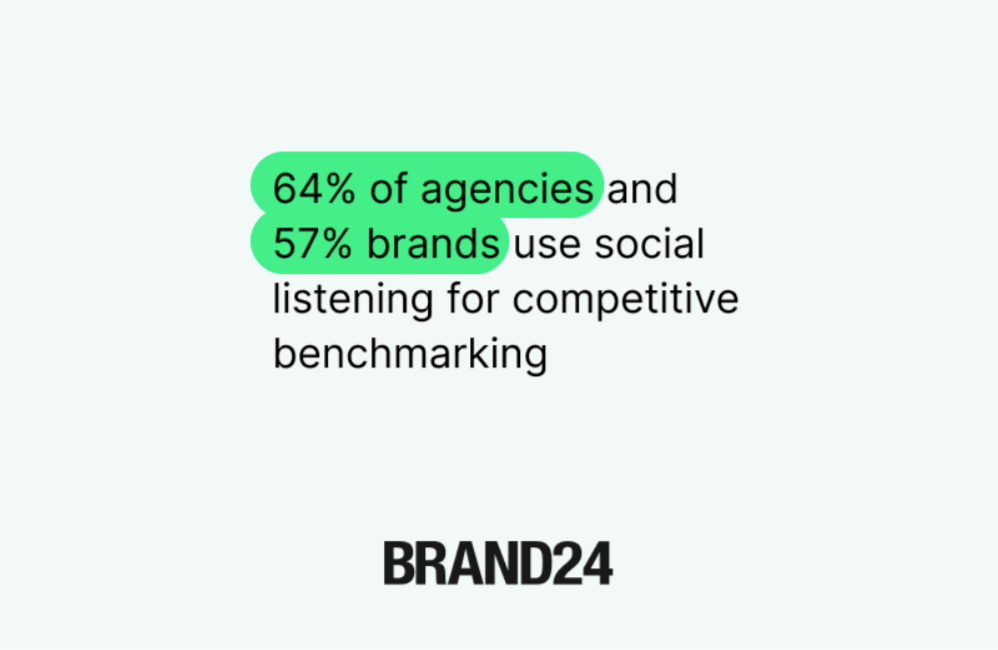
4. Powerful crisis management
Social media listening tools are made to detect early warning signs, monitor public sentiment, and help you respond before a crisis escalates.
You can discover:
- Sudden spike in mentions, especially negative ones
- The original post or comment that triggered the issue
- How the public mood is changing hour by hour or day by day
- Whether your response is working
5. Immediate trend discovery
Many brands use social listening to identify industry trends before they become mainstream. That’s because it’s one of the fastest, most scalable ways to discover what’s going on in the industry.
You can discover:
- Rising keywords, hashtags, and phrases before they spike
- Niche trends formed in specific subcultures or communities
- Influencers who started the trend
- Trends your competitors are engaging with
6. Campaign performance boost
According to Socialbakers, social listening can improve campaign return-on-investment by even 25%! How? By more accurate targeting and content creation.
Analyzing audience conversations is a game-changer for optimizing targeted marketing campaigns, as it helps us understand customer language and interests.
You can discover:
- How people feel about your campaign
- Which campaign elements trigger the strongest reactions
- Social and non-social reach of camapign
- Advertising Value Equivalent (AVE) based on online buzz
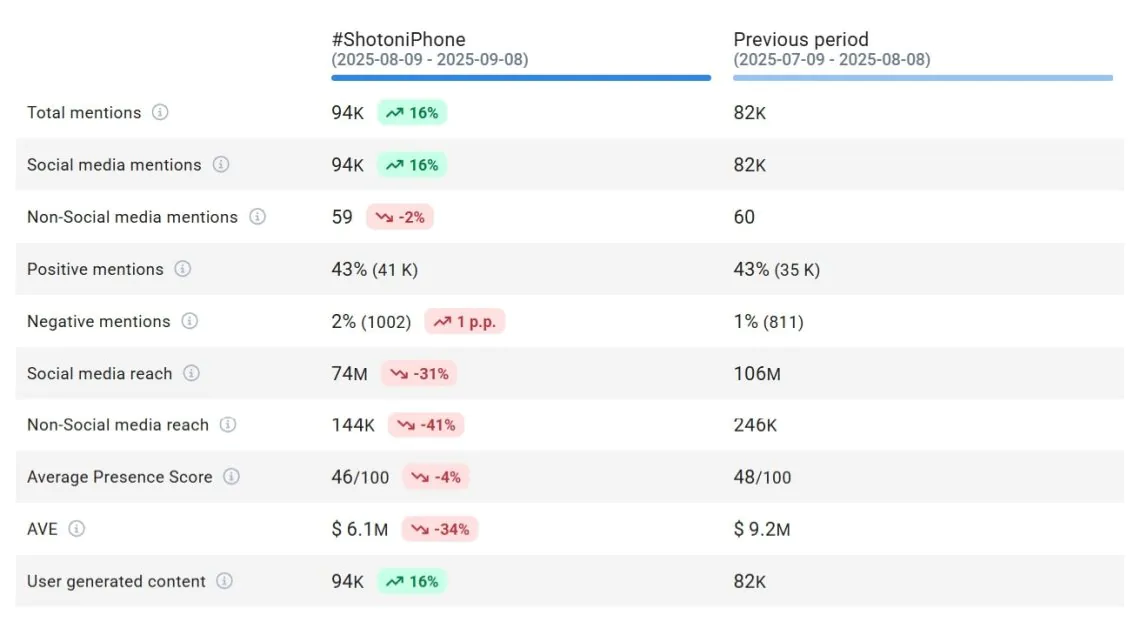
7. Improved customer satisfaction
Listening to customer conversations lets you understand their emotions & preferences, detect frequently reported issues, and – ultimately – improve customer feedback. Evidence?
According to the McKinsey report, companies implementing listening into their customer experience strategy enjoy a 17% higher customer satisfaction rate than competitors.
You can discover:
- Unfiltered, authentic customer opinions and emotions about your brand
- Complaints, frustrations, the moment of posting, even if you’re not tagged
- Which parts of the customer journey trigger the most negative reactions
- User-generated content that increases brand credibility
8. Smarter product development
By listening to social media conversations, you can design, improve, and prioritize features based on honest user feedback, not assumptions, internal bias, or limited survey responses.
You can discover:
- Unmet needs, feature requests, or frustrations in natural conversations across Reddit, X (Twitter), TikTok, forums, and reviews
- What users say they don’t use or don’t like
- Hidden expectations by analyzing how people talk about your product and competitors
- How users describe your product
How to implement social listening? Strategy
Social listening is a quite simple process, but you’ll need the right brand monitoring tool.
Of course, you can do it manually, but it’s much more time-consuming and less effective.
Below you’ll find a complete, step-by-step social listening strategy for 2026:
Step 1: Define your goals and use cases
In the beginning, decide what you want to achieve. And you have plenty to choose from:
- Brand monitoring: Track what people are saying about your brand.
- Brand health: Track negative mentions, sentiment shifts, and share of voice.
- Customer care: Spot complaints and questions outside your owned channels.
- Market intelligence: Monitor competitors, industry trends, and emerging players.
- Campaign analysis: Measure buzz, reach, and sentiment around launches.
- Crisis prevention: Detect negative sentiment spikes early and manage response.
- Product feedback: Improve products and services based on real, relevant conversations.
- Influencer discovery: Find advocates in your niche that match your business.
According to the State of Social Listening 2025, the most frequent goals for real businesses are:
- Market insights (58% of agencies and 37,5% of brands)
- Brand perception (56% of agencies and 52,8% of brands)
- Cultural & societal trend analysis (56% of agencies and 61,1% of brands)
- Crisis management (42% of agencies and 56,9% of brands)
- Content strategy (37% of agencies and 31,9% of brands)
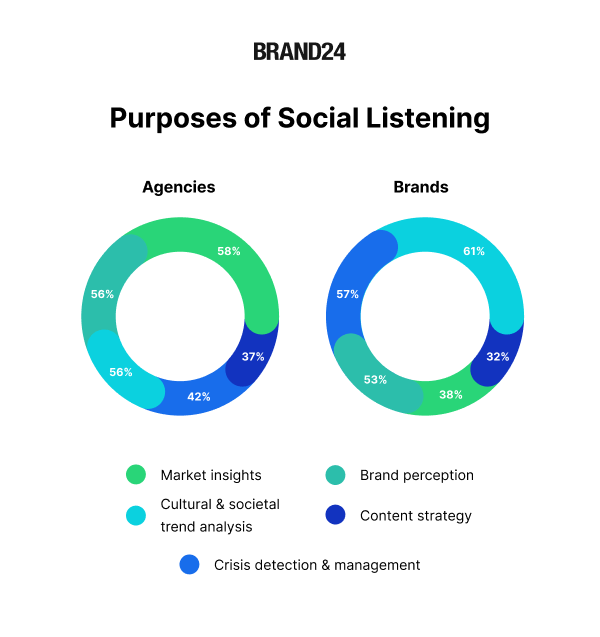
- Market insights (58% of agencies and 37,5% of brands)
- Brand perception (56% of agencies and 52,8% of brands)
- Cultural & societal trend analysis (56% of agencies and 61,1% of brands)
- Crisis management (42% of agencies and 56,9% of brands)
- Content strategy (37% of agencies and 31,9% of brands)
Remember, though, that choosing your goal or goals for your social listening strategy is not a lifetime decision! They can evolve with time.
What’s important is to have a well-defined starting point.
Step 2: Choose the right social listening tool
Advanced social listening tools research data sources automatically and help you identify the most popular and important mentions, draw valuable insights, and identify emerging trends.
So, once you have your goals in place, it is time to pick the right tool that will do most of the job for you.
Usually, you can sign up for a trial to test a tool before you buy it.
When looking for the right tool, check those 4 factors:
1. The number of monitored sources
In 2026, advanced social listening tools should scan various online sources, including:
- Social media platforms (Facebook, Instagram, X/Twitter, LinkedIn, TikTok, Bluesky, Telegram)
- Blogs and forums (Reddit, Quora)
- News sites and online magazines (e.g., Medium)
- Podcasts and video platforms (YouTube, Twitch, Spotify, Soundcloud)
- Review sites (TripAdvisor, Booking, Yelp, App Store, Google Play, Trustpilot)
- LLMs (like ChatGPT, Claude, Perplexity, and Gemini)
- Newsletters
- Multilingual and regional sources

2. Features that will support your goals
Pay attention to whether the tool constantly develops its service and offers helpful AI features.
Here are the key features to look for in 2026:
- Data collection and coverage:
- Real-time monitoring
- Historical data
- Multi-platform coverage
- Search and filtering:
- Advanced filters & Boolean search
- Noise reduction
- Analytics and insights:
- Sentiment & emotion analysis
- Intent detection
- Topic clustering
- Trends spotting
- Share of voice (SOV)
- Competitor comparison
- Reach & engagement tracking
- Geo & demographic insights
- Finding influencers
- Alerting and proactive detection:
- Event detection
- Real-time & storm alerts
- Multi-channel notifications
- AI & Advanced Intelligence:
- AI summaries, insights, and recommendations
- Built-in AI chat (ChatGPT-like)
3. Cost-effective pricing
Before buying the software, calculate the total cost of ownership, which includes:
- Subscription fee (monthly/annual).
- Add-ons (extra mentions, extra seats, advanced modules like AI or historical data).
I want you to know that large media management tools usually offer social listening as an extra add-on.
Those tools are (list updated in November 2025):
| Tool | Overview | Starting price |
| Hootsuite | An advanced social media management platform offering monitoring | Basic monitoring starts at $99, advanced social listening is offered as an add-on in a custom plan |
| HubSpot | CRM platform with a social media management toolset, including monitoring mentions | Plans start at $792 per month |
| Sprout Social | All-in-one social media management suite offering a social listening feature | Social listening is offered as an optional add-on, pricing starts at $999 per month |
On the other hand, you have tools that social listening is their core feature (list updated in November 2025):
| Tool | Overview | Starting price |
| Brand24 | AI-powered social listening and media monitoring tool | Individual plan starts at $149 |
| Mention | Social listening and media monitoring tool | Starts at $599 |
| Meltwater | Social listening platform | Around $7000 per year for a basic, 1-user subscription |
As you can see, the prices vary.
Most tools provide cost estimates upon request. To get the final price of a tool, it’s best to schedule a meeting for accurate information.
4. Opinions posted on software review websites
Checking user opinions and review sites protects you from surprises, helps you match a tool to your social listening strategy, and gives you a clearer sense of true ROI.
I recommend checking those top rankings:
- Best Social Media Monitoring Tools on G2
- Top Social Media Monitoring Software on Capterra
- Social Media Monitoring Software on Software Advice
- Top Social Media Monitoring Tools on GetApp
Step 3: Choose key terms to monitor
Social media listening tools do their job thanks to tracking keywords. Such a keyword can contain anything: a brand name, a hashtag, an industry-relevant topic, and any other phrase.
Now, your task is to define what you want to monitor. Pick the keywords that match your goals.
Think about what will work best, like:
- The name of your brand, product, or service
- Your company hashtag
- Your campaign-specific hashtag
- Your CEO’s or any other prominent employee’s name
- Your competitors’ brand names and hashtags
- Industry buzzwords
- Trending topics relevant to your niche
- Names of events you’re participating in or sponsoring
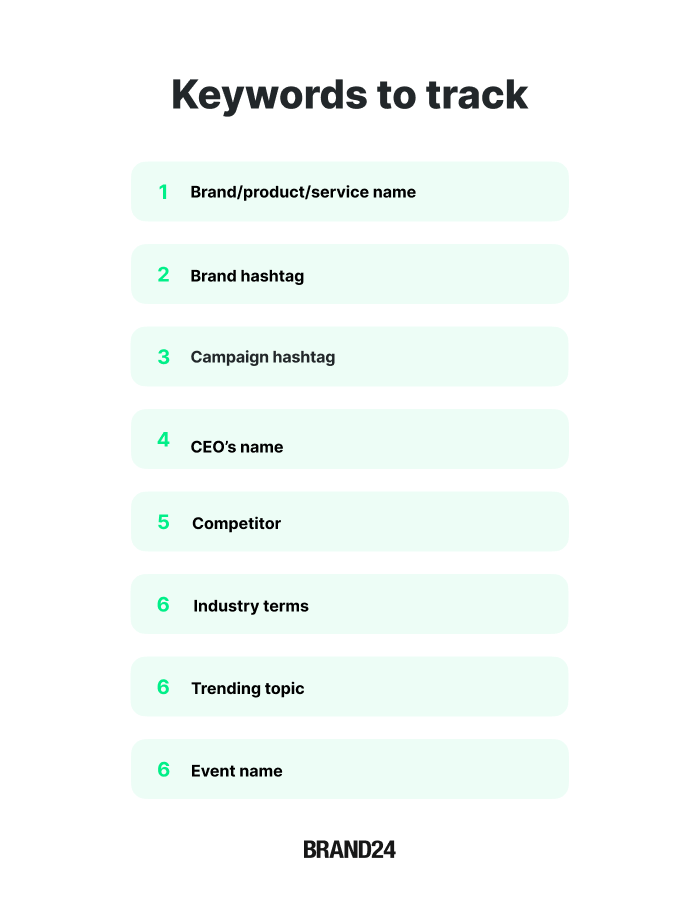
Step 4: Analyze social listening data
Now, it’s time to explore data.
In the Mentions tab, you’ll start seeing results whenever someone mentions your keywords on social & non-social platforms.
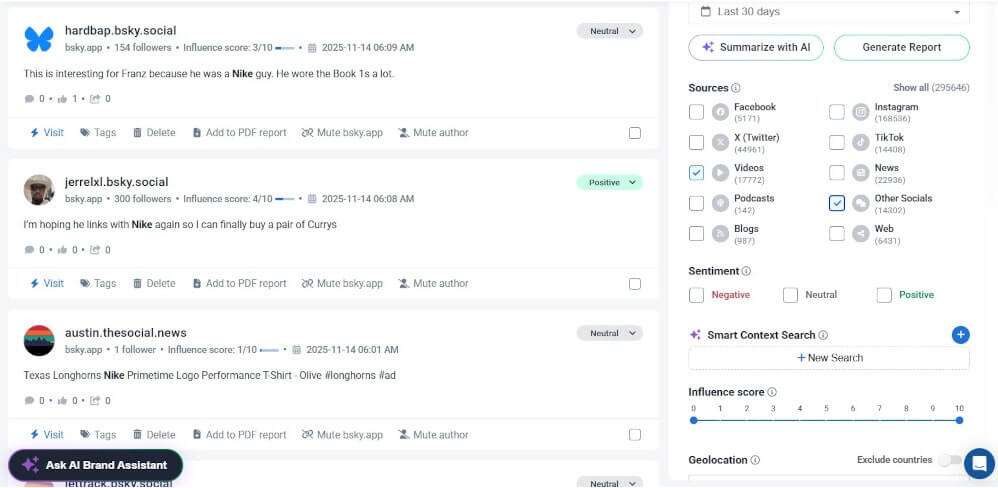
From there, you can engage with them directly or take action based on what you “hear”.
The good practice is to monitor the results regularly and respond as necessary.
Pay attention to those key social listening metrics:
- Volume of Mentions: How often are your brand, products, or keywords mentioned?
- Reach/Impressions: How many people potentially saw your brand mentions?
- Engagement: Likes, shares, comments, clicks, showing target audience interaction.
- Sentiment: Proportion of positive, negative, and neutral mentions.
- Share of Voice (SOV): – your brand’s conversation share vs. competitors.
- Trending Topics/Keywords: – common themes, hashtags, or terms linked to your brand or industry.
- Audience Demographics & Location: – who’s talking about you and where.
- Influencers/Key Sources:– individuals or sites driving the conversation.
- Response Time: How quickly and effectively does your brand respond?
- Crisis Signals/Spikes: Sudden increases in mentions or negative sentiment.
Step 5: Optimize, expand, and continue
At this stage, you have probably tested your social listening strategies. It’s time to maximize your results and reach even further.
How to do it?
Take a look at the tips written by Adam Górnicz, Customer Success Manager at Brand24, who is an expert in optimizing monitoring projects.
Optimize
Use the brand’s X (Twitter) handle, domain, or Facebook URL as keywords to boost results. Some posts may only include those forms instead of the full brand name. Catch ’em all!
Polish
Exclude irrelevant keywords to clean up your data. No need to guess, check the context of a discussion tab in the Analysis section to spot common words worth excluding.
Extend your view
Don’t just monitor your brand or competitors. Track the whole industry. It can reveal new clients, trends, and unexpected insights.
To do that:
- Create projects with industry topics and variations.
- Use the context of a discussion tab for an instant overview of key players, issues, and hot debates.
- Identify influential profiles with the Most Share of Voice or the Most Followers and follow their opinions.
- Track popular mentions, the bigger the reach, the bigger the impact.
With these tips, you’ll level up your results and feel like a true media monitoring ninja!
Social listening examples
Want to see how a well-optimized digital listening strategy can uncover valuable and actionable insights?
Check out these case studies from real brands:
Trend analysis: Neon Panda
Neon Panda, a Mexican beverage brand, uses a monitoring tool to stay culturally relevant and ahead of consumer trends.
Results: When “natural hydration” started growing as a topic among consumers, Neon Panda immediately noticed it. Then they used it to shape future messaging and product exploration.
Competitor analysis: XTB
XTB, a global trading platform, monitors competitors’ activities, including their promotions of features or offers, changes to their products, and customer complaints or negative feedback.
Results: When XTB notices competitors making changes that customers don’t like, it becomes an opportunity. For example, if a rival altered its stock investment offering and received negative feedback, XTB used that as a chance to highlight how its own offering was superior.
Improved customer experience: Pasibus
Pasibus, a Polish restaurant brand, uses a brand listening tool to detect customer feedback and meet customer expectations.
Results:
- Started a “Burger of the Month” campaign, where followers vote for what they want. This is a direct way to get feedback about menu preferences.
- After launching new or special menu items, they use the tool to monitor reactions, including reviews, shares, discussions, and what people like and dislike.
- They also track feedback from cities where they don’t yet have a restaurant. Those mentions are used to measure demand in new markets.
Link building: Chilli Fruit
Chilli Fruit, a link-building and consulting agency, tracks media mentions related to clients’ names and companies to discover backlink opportunities.
Results:
- Up to 1,500 unnotified mentions captured for more than a dozen clients. These are cases where quotes or mentions appeared in reputable publications (e.g. on Forbes, Yahoo Finance) but the client was not informed.
- About 10% of a client’s backlink requirement was satisfied through link‑building activities derived purely from monitoring mentions.
- Over 100 projects (guest post / external content) set up using data from Brand24 for content/visual enhancement.
Brand reputation: PiwikPRO
PiwikPRO, an analytics and data activation platform, uses social media listening to protect, measure, and maximize its reputation. Credibility is crucial in analytics and privacy business. Misinformation or false claims can damage trust.
Results: The team watches for “outdated or incorrect descriptions” of their product’s functions, especially in contexts of privacy, data security, and GDPR compliance. If someone has misrepresented their work, Piwik PRO responds or corrects.
Read more: Social Listening Examples From Inspiring Brands
The future of social listening 2025/2026
What can we expect in 2025 and 2026? Are there any emerging trends in the digital listening area?
I’ve asked those questions to Michał Sadowki, CEO & Founder of media monitoring and listening software.
Here are his key predictions for the coming months:
1. Social listening as fuel for AI Visibility & LLM SEO
- Brand/topic mentions turn into ranking signals for LLMs (GPT, Claude, Gemini).
- AI mentions act like the new “backlinks” for AI search visibility.
- Volume + quality of mentions on Reddit, LinkedIn, Quora, and X directly influence appearance in AI-generated answers.
- Social listening tools will help marketers identify conversations that shape how LLMs understand brands.
2. Integration with AI Assistants via MCP and similar protocols
- Growth of MCPs and API links allows real-time access to social data via chatbots/LLMs.
- By mid-2026, 40% of enterprises will use LLMs to query third-party social data (Forrester).
- Social listening evolves from passive analytics → interactive, LLM-accessible intelligence.
3. Smarter, correlative insights powered by AI
- Advanced AI models will uncover hidden links between social chatter and business results.
- Platforms like Brand24, Talkwalker, and Sprinklr are already embedding predictive analytics modules, and IDC forecasts that AI-driven insight layers will grow by 55% YoY through 2026 in social intelligence platforms.
- Expect tools to:
- Predict brand perception shifts based on sentiment and competitor buzz
- Correlate spikes in social mentions with customer churn or NPS drops
- Detect emerging influencer clusters in micro-communities before they trend
Conclusion
We’ve covered a lot today, so let’s review!
Final thoughts:
- Manual social media listening is time-consuming and less effective. Instead, use AI-powered tools that will automate the process and do most of the job for you.
- The main reasons why companies invest in social media listening are doing market research, measuring brand perception, analyzing trends, crisis detection & management, and improving content strategy.
- Social listening can help you find leads, but you must set up a project correctly and use filters smartly.
- Starting brand listening is simple, but you need to pick your goals and choose relevant keywords you want to monitor first.
- Most of the tools, like Brand24, offer a free trial so you can test them carefully.







